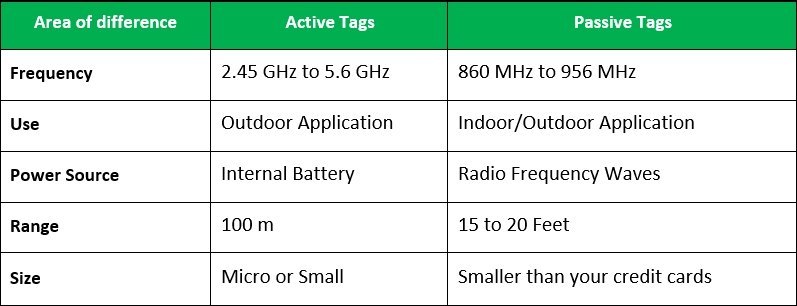RFID tags are used to store digital information within an object. They are dependent on the RFID reader for extracting the information stored within the tags in the form of smart barcodes.
RFID tags are categorized into active tags (i.e ones which operate on battery) and passive tags (which operate without any external source of power).
Passive RFID tags can are completely dependent on the power sources (electromagnetic energy) of RFID reader.
These radio waves charge up the coiled antenna present in the passive tags. After being provided with charge, power source moves from the antenna to the IC.
Thus powering the chips which then sends back the signal to the radiofrequency system. This overall process is known as backscatter which is detected by the reader and information is interpreted out of it.
The life span of passive tags depends on the environment they are operating in and also on the type of materials that they have been made of. If a tag is being operated in a better environment the life span is expected to be up to 20 years or more.
These type of tags are lesser in price than active RFID tags and even the manufacturing cost of these tags is less.
The design of these tags is very small which justifies its small manufacturing cost.
Lesser noise is generated in these tags as the circuit board is inductive as well as printed with radiative coupling.
The absence of antenna in RFID tags makes it impossible to send or receive the signals to long ranges. Thus these tags are only operating within shorter ranges irrespective of low or high frequencies.
Thus the maximum communication range can be of 2 feet.
Even if high frequency is used still the best range of these tags for connecting with readers is 20 feet, which is considerably low too.
Since the battery is absent, they are inefficient at storing too much information.
Also, Read RFID Security & Privacy Issues You Need to be Aware Of
RFID tags on their own are of no use unless an RFID reader is brought into its contact to extract the digital information stored within these tags.
To store the information, most of the sensors are dependent on constant power for everyday operations. Since no sensors are used in Passive tags, thus making it non-compatible for sensing applications.
Battery assisted passive RFID tags are also known as semi-passive or semi-active tags. They are called so because of the presence of the internal battery.
These tags are also dependent on RFID readers but their mechanism of responding differs them from that of passive tags.
In battery-assisted passive RFID tags, the internal battery while receiving the radio frequency signal from RFID reader powers the integrated circuits. Thereafter, the signals are returned by such tags to RFID readers.
For taking the complete benefits of RFID tags a lot of things need to be considered. These include labour cost and real-time data needs.
If real-time data is not important to you and labour costs are low then the passive RFID tags would be your best option.
Whereas if labour costs are high and real-time data is important then the active RFID tags make for a better solution. Below mentioned is the breakdown of the costs of different types of tags:
Such tags are priced anywhere around $0.10 USD each and are mostly utilized on paper, non-metal and liquid materials.
Larger in size than passive tags and mostly used for metal assets, these tags are valued around $ 1 USD.
Completely automated, these tags are a bit expensive ranging from $15 to $20 apiece.

Also Read:




